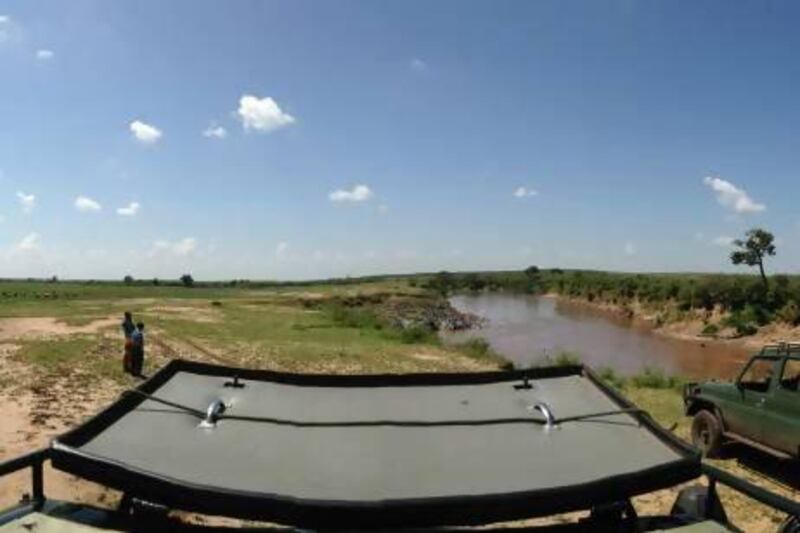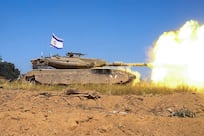Within 30 minutes of embarking on our first African safari, we see a leopard enjoying an afternoon doze in a tree.
My husband is already through one of the Land Cruiser's sunroofs, clicking away on his camera. Calvin, our 11-year-old, has a pair of binoculars glued to his eyes and is looking in the wrong direction. Moses, our guide, switches off the engine and turns around to smile at me.
"Beginner's luck?" I ask.
Maybe so. Because we also see a giraffe (Masai species, says Calvin; Moses nods in agreement), an elephant with massive tusks and a family of primates.
"They're olive baboons," says Calvin, his eyes half shut in the sun.
"He is right," says Moses in admiration.
We've just flown in from Nairobi into the Masai Mara National Reserve on an old, cramped, 12-seater Cessna through constant turbulence. It wasn't at all like the smooth, four-hour Etihad flight from Abu Dhabi to Nairobi, and I soon felt sick despite all the grandeur unfolding below: endless savannah marked with ridged cliffs and canyons, brown rivers, green clumps of bush and red earth.
Landing at noon at Keekorok Airstrip, a dirt runway with two brick huts - the office and bathrooms, respectively - my husband and I are green-faced from the hour-long flight, but Calvin is as perky as ever.
We are met by Moses and Samuel, Masai warrior guides in tribal shuka (woven cloth) and glittering necklaces, who escort us to an indestructible-looking Land Cruiser for the 45-minute drive to Sala's Camp, a "five-star" safari resort in the isolated, relatively unvisited southern end of the reserve, and the base for our four-day "glamping" adventure.
Rattling down tracks lined with rain-hardened ruts, we jam our feet against the vehicle's sides to keep from falling out of our seats. Around us are the occasional windswept tree, termite mounds topped by a bird and, everywhere, as far as the eye can see, the rolling Mara. The sweet smell of hot grass is overpowering as we go off road, flattening the undergrowth and disturbing small white butterflies that rise in clouds and flutter against our faces before finding their way out again.
Reaching Sala's Camp an hour later, still discussing the leopard's beautiful rosette markings, we meet Tony Allport, the quiet manager, who tells us that these cats are some of the most elusive animals in the reserve. The only other guests at the camp are Stef and Joel, students studying to be vets in Johannesburg, who spend their holidays tirelessly tracking wildlife in the Mara.
"It was years before I saw my first leopard. It's unfair," Joel wails.
Sala's Camp sits in a thicket of trees on the banks of the Sand River, with views out to Tanzania and the mighty Serengeti, a reserve that, at 30,000 square kilometres, makes the Mara's 1,510 square kilometres feel like a puny backyard. In August, the camp affords some of the first views of thousands of wildebeest crossing the river during the annual great migration. But we visit in January and have to make do with the river's resident hippo.
The seven tents, as well as the mess tent, are set up a good distance from each other, affording plenty of privacy. Each tent opens to reveal luxuries that are a relief to come back to after a day on the plains: running water, beds with soft sheets (and hot water bottles at night), rugs underfoot, electric lamps and an en-suite bathroom with a copper basin, toilet and shower. The furniture is all solid wood; the decor features animal motifs, including tiny, wooden giraffes sewn onto the bedspread, and ostrich eggshells and feathers.
A routine is quickly established: we are awakened at 6am by an armed ranger who escorts us to the mess tent (and again at night), just in case an animal strays into our path. Breakfast at camp is made hilarious by a white-browed robin-chat that's always trying to steal the butter. On one occasion we have breakfast in the bush - hardly 700 metres from lions we've tracked. Joel and Stef, who've ventured out in the other car, join us and we all help Samuel set up a collapsible table with coffee, tea, milk, cereals and fresh fruit, while Moses expertly cooks eggs on a small stove ingeniously rigged up in the Land Cruiser's boot.
We return at around 1pm for lunch, then retire to our tent for a short rest. After tea, we set off on the day's second game drive, heading back to camp by 6.30pm for hot showers and drinks around the campfire, all of us well wrapped against the cold night air, munching on tapioca chips and marvelling at the velvet-and-diamond sky. Dinner is eaten by candlelight around the communal table, with furry moths dive-bombing the lamps.
The meals are delicious, three-course affairs featuring everything from fresh salads, steak and potatoes to couscous and fish, with mango souffle, pomegranate coulees and other lovely treats for dessert. On the last day I ask Tony to show me the kitchen, and I gape in disbelief as I enter the tent: all it contains are two tables and a bottle of salt. The oven, which is outdoors, is a tin trunk set up on a pile of bricks and coal. Nearby is a small patch planted with herbs. I tell the Kenyan chef the food is divine - insufficient praise, I realise in retrospect - but he smiles back and thanks me fervently.
Calvin spends his afternoons between the game drives taking archery lessons and going on nature walks with Moses and Samuel. He gets slightly boastful about his skills with the rudimentary bow they've made for him, until he shoots an arrow into the river. Tony tells him he has probably hit the hippo, and for the rest of the trip Calvin is teased about the animal that is sure to hunt him down in the dead of the night, an arrow stuck in its behind.
The hippo doesn't show, of course, but other animals do: a leopard comes prowling around the camp at 2am on our first night, its mewling sounding exactly like a bird. On other nights there are baboons in the trees, and once we hear lions; they are miles away but are so loud they could've been outside our tent.
We've philosophically decided we won't go in search of any particular animal but would take what comes to us. And we are amply rewarded. Moses and Samuel know the land like the back of their hand, and each expedition brings us within a few feet of cheetah, mongoose, zebras, hartebeest, topi, waterbucks, impala, dik-dik, eagles, deer, giraffes, secretary birds and elephants with adorable calves in tow, their Africa-shaped ears flapping like slow punkahs. Wild boar - locally called "Kenya Express" because of their antenna-like tails and the speed at which they run - are everywhere.
Once, on our way back from sighting crocodiles in the Mara River, we come upon a family of bat-eared foxes, the babies tumbling and squealing. On seeing us they all sit up straight, poised for flight, their pretty, oversized ears quivering comically.
But most unforgettable is the afternoon of our second day. Driving up a hill, we find ourselves among more than a thousand buffaloes. Each time we try to drive through, they trot up, retreat, then approach again, staring unblinkingly. We sit there for nearly an hour; even Calvin stays still, gazing back at the inquisitive animals.
By the third day, we have four game drives behind us and have ticked off three of the big five: leopard, buffalo and elephant. We are still to see lions and rhino.
Then we come upon our first eland; it's lying in the grass, all magnificent head, curving antlers and limpid eyes. But the rest of it is gone. A few feet away is a tangle of grey intestines. We are downwind and the smell is dreadful.
"Wild," says Calvin.
"Pooh," I say.
"Lions!" whispers Moses.
We find them within minutes, a pride of seven females and two young males lying somnambulant in the shade of bushes, their bellies bloated, traces of blood still around their mouths, golden hides covered in flies. Moses silently climbs to the top of the vehicle and points to a dozen slow-moving shapes in the grass behind us - the hyenas have arrived; they have smelled the kill.
We return to camp for lunch, looking forward to the afternoon when, surely, we are going to find a rhino. To ensure this happens, we take a different route, looping around the Sand River and into the Serengeti. Then Moses pulls up suddenly, jumps out and bends over two insects rolling a giant ball of what looks like elephant droppings.
"Dung beetles," says Calvin, and is outside in a trice. We spend at least half an hour following them to their lair, a hole in the ground cleverly concealed under shrubs, where, Moses explains, a female is waiting to receive this generous offering. It's a while before we can drag Calvin away from his "favourite bugs".
We come upon huge prints in soft, dark mud about an hour later.
"Rhino tracks," shouts Calvin, who's with Samuel on the car roof. Moses leans out of his window for a look. "Today is your lucky day," he grins, and changing gears with a terrific noise, we plunge into the bush.
Then grey clouds loom up from nowhere. Soon the rain is coming down horizontally, drenching us as we struggle to roll up the stiff, mud-caked windows and slam down the covers on the sunroofs. The shower doesn't last long but it has put paid to any more rhino tracking in Africa - we have to fly out the next morning.
Samuel opens up a box of drinks and we all sit around, dejectedly sipping Stoney Tangawizi ginger beer, Kenya's all-time favourite soda pop.
Suddenly Calvin yells, pointing to the sky: the clouds have parted, the landscape is flooded with an otherworldly half-light and arching above this blurred, watercolour-like scene are two - yes, two - bright rainbows.
"Dung beetles and rainbows," says Calvin, taking off his sopping T-shirt. "Now that's what game drives are all about."
Follow us
[ @TravelNational ]





